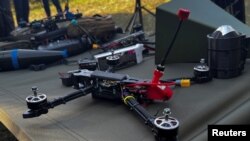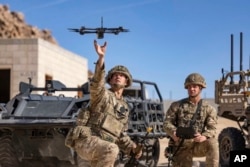This week, as Taiwan was preparing for the start of its Han Kuang military exercises, its air defense system detected a Chinese drone circling the island. This was the sixth time that China had sent a drone to operate around Taiwan since 2023.
Drones like the one that flew around Taiwan, which are tasked with dual-pronged missions of reconnaissance and intimidation, are just a small part of a broader trend that is making headlines from Ukraine to the Middle East to the Taiwan Strait and is changing the face of warfare.
The increasing role that unmanned aerial vehicles, or UAVs, play and rising concern about a Chinese invasion of democratically ruled Taiwan is pushing Washington, Beijing and Taipei to improve the sophistication, adaptability and cost of drone technology.
'Hellscape' strategy
Last August, the Pentagon launched a $1 billion Replicator Initiative to create air, sea and land drones in the "multiple thousands," according to the Defense Department's Innovation Unit. The Pentagon aims to build that force of drones by August 2025.
The initiative is part of what U.S. Admiral Samuel Paparo recently described to The Washington Post as a "hellscape" strategy, which aims to counter a Chinese invasion of Taiwan through the deployment of thousands of unmanned drones in the air and sea between the island and China.
"The benefits of unmanned systems are that you get cheap, disposable mass that's low cost. If a drone gets shot down, the only people that are crying about it are the accountants," said Zachary Kallenborn, a policy fellow at George Mason University. "You can use them at large amounts of scale and overwhelm your opponents as well as degrade their defensive capabilities."
The hellscape strategy, he added, aims to use lots of cheap drones to try to hold back China from attacking Taiwan.
Drone manufacturing supremacy
China has its own plans under way and is the world's largest manufacturer of commercial drones. In a news briefing after Paparo's remarks to the Post, it warned Washington that it was playing with fire.
"Those who clamor for turning others' homeland into hell should get ready for burning in hell themselves," said Senior Colonel Wu Qian, spokesperson for the Chinese defense ministry.
"The People's Liberation Army is able to fight and win in thwarting external interference and safeguarding our national sovereignty and territorial integrity. Threats and intimidation never work on us," Wu said.
China's effort to expand its use of drones has been bolstered, analysts say, by leader Xi Jinping's emphasis on technology and modernization in the military, something he highlighted at a top-level party meeting last week.
"China's military is developing more than 50 types of drones with varying capabilities, amassing a fleet of tens of thousands of drones, potentially 10 times larger than Taiwan and the U.S. combined," Michael Raska, assistant professor at Singapore's Nanyang Technological University, told VOA in an email. "This quantitative edge currently fuels China's accelerating military modernization, with drones envisioned for everything from pre-conflict intel gathering to swarming attacks."
Analysts add that China's commercial drone manufacturing supremacy aids its military in the push for drone development. China's DJI dominates in production and sale of household drones, accounting for 76% of the worldwide consumer market in 2021.
The scale of production and low price of DJI drones could put China in an advantageous position in a potential drone war, analysts say.
"In Russia and Ukraine, if you have a lot of drones – even if they're like the commercial off-the-shelf things, DJI drones you can buy at Costco – and you throw hundreds of them at an air defense system, that's going to create a large problem," said Major Emilie Stewart, a research analyst at the China Aerospace Studies Institute.
China denies it is seeking to use commercial UAV technology for future conflicts.
"China has always been committed to maintaining global security and regional stability and has always opposed the use of civilian drones for military purposes," Liu Pengyu, spokesperson for the Chinese Embassy in Washington, told VOA. "We are firmly opposed to the U.S.'s military ties with Taiwan and its effort of arming Taiwan."
Drone force
With assistance from its American partners, pressure from China and lessons from Ukraine, Taiwan has been pushing to develop its own domestic drone warfare capabilities.
The United States has played a pivotal role in Taiwan's drone development, and just last week it pledged to sell $360 million of attack drones to the Taipei Economic and Cultural Representative Office, or TECRO, Taiwan's de facto embassy in Washington.
"Taiwan will continue to build a credible deterrence and work closely with like-minded partners, including the United States, to preserve peace and stability in the region," TECRO told VOA when asked about the collaboration between Taipei and Washington. "We have no further information to share at this moment."
The effort to incorporate drones into its defense is crucial for Taiwan, said Eric Chan, a senior nonresident fellow at the Global Taiwan Institute.
"The biggest immediate effects of the U.S. coming into this mass UAV game is to give Taiwan a bigger advantage to be able to, first, detect their enemy and, second, help them build a backstop to their own capabilities as well," Chan said.
With the potential for China to consider using drones in an urban conflict environment, Taiwan is recognizing the importance of stepping up its counter-drone defense systems.
"After multiple intrusions of Chinese drones in outlying islands, the Taiwan Ministry of Defense now places great emphasis on anti-drone capabilities," said Yu-Jiu Wang, chief executive of Tron Future, an anti-drone company working with the Taiwanese military.
The demand is one that Wang said his company is willing and ready to fill.


